The novel ETS factor TEL2 cooperates with Myc in B lymphomagenesis
- PMID: 15743832
- PMCID: PMC1061619
- DOI: 10.1128/MCB.25.6.2395-2405.2005
The novel ETS factor TEL2 cooperates with Myc in B lymphomagenesis
Abstract
The human ETS family gene TEL2/ETV7 is highly homologous to TEL1/ETV6, a frequent target of chromosome translocations in human leukemia and specific solid tumors. Here we report that TEL2 augments the proliferation and survival of normal mouse B cells and dramatically accelerates lymphoma development in Emu-Myc transgenic mice. Nonetheless, inactivation of the p53 pathway was a hallmark of all TEL2/Emu-Myc lymphomas, indicating that TEL2 expression alone is insufficient to bypass this apoptotic checkpoint. Although TEL2 is infrequently up-regulated in human sporadic Burkitt's lymphoma, analysis of pediatric B-cell acute lymphocytic leukemia (B-ALL) samples showed increased coexpression of TEL2 and MYC and/or MYCN in over one-third of B-ALL patients. Therefore, TEL2 and MYC also appear to cooperate in provoking a cadre of human B-cell malignancies.
Figures
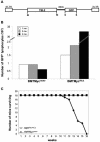
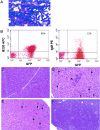

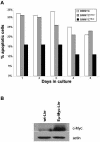
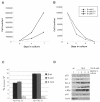
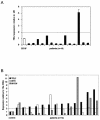
Similar articles
-
Id2 is dispensable for myc-induced lymphomagenesis.Cancer Res. 2004 Oct 15;64(20):7296-301. doi: 10.1158/0008-5472.CAN-04-2133. Cancer Res. 2004. PMID: 15492249
-
The ETS factor TEL2 is a hematopoietic oncoprotein.Blood. 2006 Feb 1;107(3):1124-32. doi: 10.1182/blood-2005-03-1196. Epub 2005 Oct 18. Blood. 2006. PMID: 16234363 Free PMC article.
-
Myc suppression of Nfkb2 accelerates lymphomagenesis.BMC Cancer. 2010 Jul 2;10:348. doi: 10.1186/1471-2407-10-348. BMC Cancer. 2010. PMID: 20598117 Free PMC article.
-
Impact of MYC on malignant behavior.Hematology Am Soc Hematol Educ Program. 2014 Dec 5;2014(1):100-6. doi: 10.1182/asheducation-2014.1.100. Epub 2014 Nov 18. Hematology Am Soc Hematol Educ Program. 2014. PMID: 25696841 Review.
-
Translocations involving c-myc and c-myc function.Oncogene. 2001 Sep 10;20(40):5595-610. doi: 10.1038/sj.onc.1204595. Oncogene. 2001. PMID: 11607812 Review.
Cited by
-
Mapping of MN1 sequences necessary for myeloid transformation.PLoS One. 2013 Apr 23;8(4):e61706. doi: 10.1371/journal.pone.0061706. Print 2013. PLoS One. 2013. PMID: 23626719 Free PMC article.
-
The PKR-Like Endoplasmic Reticulum Kinase Promotes the Dissemination of Myc-Induced Leukemic Cells.Mol Cancer Res. 2019 Jul;17(7):1450-1458. doi: 10.1158/1541-7786.MCR-19-0002. Epub 2019 Mar 22. Mol Cancer Res. 2019. PMID: 30902831 Free PMC article.
-
Identifying new targets in leukemogenesis using computational approaches.Saudi J Biol Sci. 2015 Sep;22(5):610-22. doi: 10.1016/j.sjbs.2015.01.012. Epub 2015 Jan 20. Saudi J Biol Sci. 2015. PMID: 26288567 Free PMC article.
-
Integrated Analysis of the ETS Family in Melanoma Reveals a Regulatory Role of ETV7 in the Immune Microenvironment.Front Immunol. 2020 Dec 23;11:612784. doi: 10.3389/fimmu.2020.612784. eCollection 2020. Front Immunol. 2020. PMID: 33424867 Free PMC article.
-
ETV7 is an essential component of a rapamycin-insensitive mTOR complex in cancer.Sci Adv. 2018 Sep 12;4(9):eaar3938. doi: 10.1126/sciadv.aar3938. eCollection 2018 Sep. Sci Adv. 2018. PMID: 30258985 Free PMC article.
References
-
- Adams, J. M., A. W. Harris, C. A. Pinkert, L. M. Corcoran, W. S. Alexander, S. Cory, R. D. Palmiter, and R. L. Brinster. 1985. The c-myc oncogene driven by immunoglobulin enhancers induces lymphoid malignancy in transgenic mice. Nature 318:533-538. - PubMed
-
- ar-Rushdi, A., K. Nishikura, J. Erikson, R. Watt, G. Rovera, and C. M. Croce. 1983. Differential expression of the translocated and the untranslocated c-myc oncogene in Burkitt lymphoma. Science 222:390-393. - PubMed
-
- Bates, S., A. C. Phillips, P. A. Clark, F. Stott, G. Peters, R. L. Ludwig, and K. H. Vousden. 1998. p14ARF links the tumour suppressors RB and p53. Nature 395:124-125. - PubMed
-
- Baudino, T. A., K. H. Maclean, J. Brennan, E. Parganas, C. Yang, A. Aslanian, J. A. Lees, C. J. Sherr, M. F. Roussel, and J. L. Cleveland. 2003. Myc-mediated proliferation and lymphomagenesis, but not apoptosis, are compromised by E2f1 loss. Mol. Cell 11:905-914. - PubMed
Publication types
MeSH terms
Substances
Grants and funding
LinkOut - more resources
Full Text Sources
Other Literature Sources
Molecular Biology Databases
Research Materials
Miscellaneous
